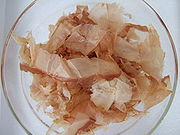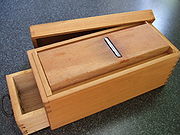
Katsuobushi
Encyclopedia

Japanese language
is a language spoken by over 130 million people in Japan and in Japanese emigrant communities. It is a member of the Japonic language family, which has a number of proposed relationships with other languages, none of which has gained wide acceptance among historical linguists .Japanese is an...
name for dried, fermented
Fermentation (food)
Fermentation in food processing typically is the conversion of carbohydrates to alcohols and carbon dioxide or organic acids using yeasts, bacteria, or a combination thereof, under anaerobic conditions. Fermentation in simple terms is the chemical conversion of sugars into ethanol...
, and smoked skipjack tuna
Skipjack tuna
The skipjack tuna, Katsuwonus pelamis, is a medium-sized perciform fish in the tuna family, Scombridae. It is otherwise known as the aku, arctic bonito, mushmouth, oceanic bonito, striped tuna, or victor fish...
(Katsuwonus pelamis, sometimes referred to as bonito
Bonito
Bonito is a name given to various species of medium-sized, predatory fish in the Scombridae family. First, bonito most commonly refers to species in the genus Sarda, including the Atlantic bonito and the Pacific bonito ; second, in Japanese cuisine, bonito refers to the skipjack tuna , which, in...
).
Shaved Katsuobushi and dried kelp - kombu
Kombu
Kombu or konbu , also called dashima or haidai , is edible kelp from the family Laminariaceae widely eaten in East Asia....
- are the main ingredients of dashi
Dashi
Dashi is a class of soup and cooking stock, considered fundamental to Japanese cooking. In 1980, Shizuo Tsuji wrote: "Many substitutes for dashi are possible, but without dashi, dishes are merely à la japonaise and lack the authentic flavor." Dashi forms the base for miso soup, clear broth, noodle...
, a broth that forms the basis of many soups (such as miso
Miso soup
is a traditional Japanese soup consisting of a stock called "dashi" into which is mixed softened miso paste. Many ingredients are added depending on regional and seasonal recipes, and personal preference.-Miso paste:...
) and sauces (e.g., soba
Soba
is the Japanese name for buckwheat. It is synonymous with a type of thin noodle made from buckwheat flour, and in Japan can refer to any thin noodle . Soba noodles are served either chilled with a dipping sauce, or in hot broth as a noodle soup...
no tsukejiru) in Japanese cuisine
Japanese cuisine
Japanese cuisine has developed over the centuries as a result of many political and social changes throughout Japan. The cuisine eventually changed with the advent of the Medieval age which ushered in a shedding of elitism with the age of shogun rule...
.
Katsuobushi's distinct umami
Umami
Umami , popularly referred to as savoriness, is one of the five basic tastes together with sweet, sour, bitter, and salty.-Etymology:Umami is a loanword from the Japanese meaning "pleasant savory taste". This particular writing was chosen by Professor Kikunae Ikeda from umai "delicious" and mi ...
flavor comes from its high inosinic acid
Inosinic acid
Inosinic acid or inosine monophosphate is a nucleotide monophosphate. Inosinic acid is important in metabolism. It is the ribonucleotide of hypoxanthine and the first nucleotide formed during the synthesis of purine. It is formed by the deamination of adenosine monophosphate, and is hydrolysed...
content. Traditionally made katsuobushi, known as karebushi, is deliberately planted with Aspergillus
Aspergillus
Aspergillus is a genus consisting of several hundred mold species found in various climates worldwide. Aspergillus was first catalogued in 1729 by the Italian priest and biologist Pier Antonio Micheli...
glaucus fungus in order to reduce moisture.
Traditional production process

The fillets are then smoked using oak, pasania, or castanopsis wood until the fish has dried. Tar and dirt are then shaved from the surface and the fish set to further dry in the sun. The fish is then sprayed with Aspergillus glaucus culture and left in a closed room for the mold to grow.
As it grows, the mold is repeatedly shaved off until it ceases to take hold. The fish will become hard and dry as wood. Less than 20% of its original weight, it is known as called karebushi (枯節) or honkarebushi
Honkarebushi
Honkarebushi, is a Japanese traditional food made with dried fish. Before eating, it is usually sliced and mixed with sauces....
(本枯節).
Shaving

Plane (tool)
A hand plane is a tool for shaping wood. When powered by electricity, the tool may be called a planer. Planes are used to flatten, reduce the thickness of, and impart a smooth surface to a rough piece of lumber or timber. Planing is used to produce horizontal, vertical, or inclined flat surfaces on...
.
Katsuobushi is today typically found in bags of small pink-brown shavings. Smaller, thinner shavings, called hanakatsuo (花鰹; はなかつお), are used as a flavoring and topping for many Japanese dishes, such as okonomiyaki
Okonomiyaki
is a Japanese dish containing a variety of ingredients. The name is derived from the word okonomi, meaning "what you like" or "what you want", and yaki meaning "grilled" or "cooked" . Okonomiyaki is mainly associated with Kansai or Hiroshima areas of Japan, but is widely available throughout the...
. Larger, thicker shavings, called kezurikatsuo (削り鰹; けずりかつお), are used to make the ubiquitous dashi stock.
Uses
In addition to making dashi, other popular uses of katsuobushi include:- Okaka (おかか), finely chopped katsuobushi dressed with soy sauce.
- As a stuffing for rice balls (onigiriOnigiri, also known as or rice ball, is a Japanese food made from white rice formed into triangular or oval shapes and often wrapped in nori . Traditionally, an onigiri is filled with pickled ume , salted salmon, katsuobushi, kombu, tarako, or any other salty or sour ingredient as a natural preservative...
). - As a topping for rice. Popular for bentōBentois a single-portion takeout or home-packed meal common in Japanese cuisine. A traditional bento consists of rice, fish or meat, and one or more pickled or cooked vegetables, usually in a box-shaped container. Containers range from disposable mass produced to hand crafted lacquerware...
, often covered with noriNoriis the Japanese name for various edible seaweed species of the red alga Porphyra including most notably P. yezoensis and P. tenera, sometimes called laver. Finished products are made by a shredding and rack-drying process that resembles papermaking...
. - Dried okaka is used as an ingredient of furikakeFurikakeis a dry Japanese condiment meant to be sprinkled on top of rice. It typically consists of a mixture of dried and ground fish, sesame seeds, chopped seaweed, sugar, salt, and monosodium glutamate...
rice topping (called "okaka furikake").
- As a stuffing for rice balls (onigiri
- As a seasoning for cold tofuTofuis a food made by coagulating soy milk and then pressing the resulting curds into soft white blocks. It is part of East Asian and Southeast Asian cuisine such as Chinese, Japanese, Korean, Indonesian, Vietnamese, and others. There are many different varieties of tofu, including fresh tofu and tofu...
(hiyayakkoHiyayakkois a popular Japanese dish made with chilled tofu and toppings. It is usually served during the summer season. There are two kinds of tofu used in hiyayakko: kinugoshi , which is more frequently used, and the less common momen ....
, 冷奴) along with grated gingerGingerGinger is the rhizome of the plant Zingiber officinale, consumed as a delicacy, medicine, or spice. It lends its name to its genus and family . Other notable members of this plant family are turmeric, cardamom, and galangal....
and Welsh onionWelsh onionAllium fistulosum L. is a perennial onion. Other names that may be applied to this plant include green onion, spring onion, escallion, and salad onion...
(a type of spring onion.) - Sprinkled with sesameSesameSesame is a flowering plant in the genus Sesamum. Numerous wild relatives occur in Africa and a smaller number in India. It is widely naturalized in tropical regions around the world and is cultivated for its edible seeds, which grow in pods....
seeds and chopped noriNoriis the Japanese name for various edible seaweed species of the red alga Porphyra including most notably P. yezoensis and P. tenera, sometimes called laver. Finished products are made by a shredding and rack-drying process that resembles papermaking...
atop cold soba noodles (zarusobaSobais the Japanese name for buckwheat. It is synonymous with a type of thin noodle made from buckwheat flour, and in Japan can refer to any thin noodle . Soba noodles are served either chilled with a dipping sauce, or in hot broth as a noodle soup...
). - As a topping on takoyakiTakoyakiis a popular ball-shaped Japanese dumpling or more like a savory pancake made of batter and cooked in a special takoyaki pan...
and okonomiyakiOkonomiyakiis a Japanese dish containing a variety of ingredients. The name is derived from the word okonomi, meaning "what you like" or "what you want", and yaki meaning "grilled" or "cooked" . Okonomiyaki is mainly associated with Kansai or Hiroshima areas of Japan, but is widely available throughout the...
. - As a seasoning on century eggCentury eggCentury egg or pidan , also known as preserved egg, hundred-year egg, thousand-year egg, thousand-year-old egg, and millennium egg, is a Chinese cuisine ingredient made by preserving duck, chicken or quail eggs in a mixture of clay, ash, salt, lime, and rice hulls for several weeks to several...
along with sesame oilSesame oilSesame oil is an edible vegetable oil derived from sesame seeds. Besides being used as a cooking oil in South India, it is often used as a flavor enhancer in Chinese, Japanese, Korean, and to a lesser extent Southeast Asian cuisine.The oil from the nutrient rich seed is popular in alternative...
and soy sauceSoy sauceSoy sauce is a condiment produced by fermenting soybeans with Aspergillus oryzae or Aspergillus sojae molds, along with water and salt...
. - As a high-protein treat for catCatThe cat , also known as the domestic cat or housecat to distinguish it from other felids and felines, is a small, usually furry, domesticated, carnivorous mammal that is valued by humans for its companionship and for its ability to hunt vermin and household pests...
s sold at pet stores.
External links
- Video of dancing fish flakes
- an interesting description of katsuobushi seen in the Tsukiji fish marketTsukiji fish marketThe , commonly known as the , is the biggest wholesale fish and seafood market in the world and also one of the largest wholesale food markets of any kind. The market is located in Tsukiji in central Tokyo, and is a major attraction for foreign visitors....
- Production images of katsuobushi

